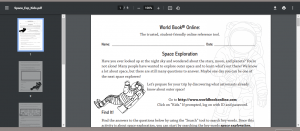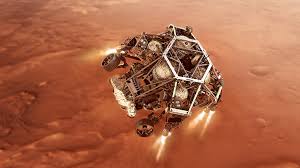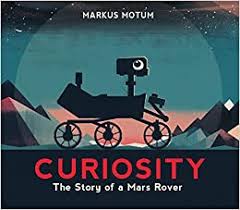For this assignment, I will review, select and curate 10 resources that I would include in an inquiry plan about Space Exploration for a grade 6 class. I chose the topic of Space Exploration based on the level of interest that the students have in this topic. The topic is relevant because it helps to address fundamental questions about our place in the Universe and the history of our solar system. It is relevant because there have been many advances in space exploration this year and students should be in touch with exciting current events that occur in their lifetime. It is essential for students to know what is happening in the real world and be able to make connections. Using specific criteria, I will evaluate each resource and explain my rationale for why I chose the resource.

image by planitaty-science.org
Choosing good resources to support an inquiry plan is essential. Teachers need to provide the students with resources that are credible, educational, of different media formats, at appropriate reading, listening, viewing, and cognitive levels for all students. Good resources allow the students to develop skills for efficient inquiry. Most of the resources that I have chosen for this assignment are available to me through the various subscriptions provided by my current school division. The books are available through my current school learning library commons.
I have selected each resource using specific guidelines and criteria. The BC Ministry of Education explains that an appropriate resource is one that:
“- supports the learning standards or learning outcomes of the curriculum
-assists students in making connections between what they learn in school and real-life applications
-are developmentally and age-appropriate
-have effective instructional and technical design
-meet the requirements set by copyright and privacy legislations
-are suitable based on social consideration” (BC Ministry of Education)
Keeping this in mind, I will use the following criteria for selecting quality resources for a Space Exploration inquiry plan.
a. Curriculum links: Is the resource linked to curriculum outcomes?
b. Real-Life applications: Does the resource allow the student to make connections to the real world?
c. Age and ability appropriate: Are the resources age-appropriate? Is the resource accessible to all student abilities? Can the resource be altered or adapted to fit the abilities of the students?
d. Usability: Is the resource easy to use? How much time does the resource require to fully understand and use?
e. Social consideration: Does the resource offer the students the opportunity to practice their social skills?
f. Credibility: Does the resource get a good review? Does the resource come from a credible source?
Space Exploration Resources
- Breakout EDU – Space Exploration https://platform.breakoutedu.com/game/explore-mission-to-mars Breakout EDU, www.platform.breakoutedu.com/
Breakout Edu is an immersive learning games platform. The website offers a breakout game called Space Exploration. The game consists of a combination of physical and digital puzzle elements aligned with curriculum standards that must be solved in a set amount of time. Players of all ages and abilities are challenged to solve the digital puzzles or open the locked Breakout EDU box using critical thinking, collaboration, and creativity. Since my school division acquired a membership to the Breakout EDU website, I have been able to test some of the strongbox puzzles. The students have a lot of fun working together to solve the puzzle. The most important thing would be to choose puzzles that are age-appropriate and not too difficult to solve. If the puzzles are too difficult then the students are likely to give up. The topic of space is part of the Manitoba Grade 6 Science curriculum. The puzzles can be modified or adapted to fit student ability and each Breakout puzzle contain suggested age groups. The website provides step-by-step instructions for each puzzle and kit puzzles can be printed. Each game includes a section with suggested reflection questions, puzzle answer key, and introduction storyline. This platform is like the concept of a board game. Harris & Mayer (2010), talk about “modern board games” that are more cooperative and open-ended, with a focus on teamwork, strategy, and planning, rather than elimination. Breakout EDU activities are just that, “the modern boardgame” where students work as a team. Working cooperatively offers the students the opportunity to improve their social skills, to practice good listening skills, and patience. This is supported by Harris and Mayer when they state “Gaming, that structured form of interaction bound by rules with players working towards an end goal, must be learned.” (2010)
 image by Breakout EDU
image by Breakout EDU
- WorldBook Online Encyclodepia – Space Exploration Webquest
“World Book Online Reference Center: Online Reference Book: Online Encyclopedia.” World Book, www.worldbookonline.com
The Space Exploration Webquest is an activity available through the Teacher Tool section of Worldbook Online. It is very engaging to students as they work independently to explore the Worldbook website and learn about space exploration. Each Webquest is curriculum correlated and students with reading difficulties can use the read-aloud option. This activity allows students to practice their foundational knowledge. Students follow the easy-to-use step-by-step expedition instructions through Worldbook Online to learn about space exploration. Through the Webquest, students learn about space exploration by reading text, observing images, and listening to sounds related to space. The activity is easy to access and each Webquest can be printed. Webquest offers the students the opportunity to improve their technological capacities and research skills by moving through the World Book Online database. I have tried out a few Worldbook Webquests. The students enjoy doing them. I suggest that the teacher choose a Webquest to complete as a class. This will allow the students to follow along and practice their skills before completing one independently. These types of activities can be classified as being a web game. Harris and Mayer state that these kinds of activities “provide a unique and authentic opportunity for developmentally appropriate growth through play.” (2010)
 image by Worldbook Online
image by Worldbook Online
- Article: The History of Space Exploration – “To the Moon and Beyond: A Brief History of Space Exploration.” Tech Will Save Us, 13 Nov. 2019, techwillsaveus.com/blog/history-of-space-exploration/
The article entitled To the Moon and Beyond: A Brief History of Space Exploration can be found on the techwillsaveus.com website. The article gives the reader a description of the important space exploration events in history which is linked to real-life. The article is easy to read. It offers links to more in-depth information about various topics such as V2 Rocket, famous astronauts, and SpaceX. The article includes images of space and video footage related to each historical event. The theme-based article offers an abundance of information about space exploration. The content of the article is current and engaging. It supports the criteria and can be used in part of a text set as described in Module 6 of course 469: “It can be used with an inquiry approach to reading and discussing to deepen understanding, or it may be collected to support a specific topic for historical or scientific inquiry.” (UBC, course 469, Module 5, 2021). In my experience, I have taken explored similar articles about various topics with my students. I suggest that the teacher project the article on the whiteboard and ask students to create a timeline of the most important events to get the most out of the article.
 image by nasa.gov
image by nasa.gov
- Nasa Website – “NASA’s Mars Exploration Program.” NASA, NASA, 3 June 2014,
https://mars.nasa.gov/#red_planet/0
The Nasa Science Mars Exploration Program is dedicated to offering readers up-to-date information about the Mars exploration program. The Red Planet section offers sections on Nasa Science goals, information about the planet itself and its atmosphere, astrobiology, and a past, present, and future timeline. Each section provides links to topic information. This website links to the grade 6 Manitoba Science curriculum. The information provided is current and relevant to what is happening in our world today regarding space exploration. The information is easy to access at an easy reading level. Individual articles are clear, concise, and brief which allows for easy understanding. I feel that it is important to offer the students websites that are known to be reliable and safe as it may be risky to allow the students to search the Internet at will. The website is peer-reviewed, and the results are published through PubSpace.
https://sti.nasa.gov/submit-to-pubspace/#.YDpwpmhKjIU
It is a reliable website as it is a government agency that is responsible for science and technology related to air and space. The agency was created to oversee U.S. space exploration and aeronautics research.
 image by nasa.gov
image by nasa.gov
- Interview an astronaut article
“8 Questions for Andrew Morgan.” Time for Kids, 11 Feb. 2021, www.timeforkids.com/g56/8-questions-for-andrew-morgan-2/. https://www.timeforkids.com/g56/8-questions-for-andrew-morgan-2/
This article encapsulates an interview between three children and Astronaut Andrew Morgan. Time for Kids is a reputable source for information. https://www.commonsense.org/education/website/time-for-kids. The text is informative and not too extensive. It is comprised of 8 questions formulated by children making the text easy to read. The article also highlights in yellow some of the articles’ more difficult vocabulary. Clicking on the yellow word leads to an audio pronunciation, definition, and visual representation of the word. The end of the article includes a more in-depth video interview with Andrew Morgan. The text can be used as a model to develop questioning skills and for those who have difficulty reading, they can access the video interview. The student will be engaged when reading this article because they can relate to the kids that performed the interview. The questions asked are at grade level and the topic relates to real life. Field professionals are a great resource to get the human perspective and demonstrating real-world knowledge and experiences. Students could use this interview as a model for their own. Students can create questions and answers based on their research of space exploration.
 image by nasa.gov
image by nasa.gov
- DK Space-A Visual Encyclopedia in Print “Space a Visual Encyclopedia.” Dkbooks, Published by DK Children, 18 Aug. 2020,
www.dk.com/us/book/9781465496850-space-a-visual-encyclopedia/
This encyclopedia is geared to students in grades 2 to 6. Students can access the 4-page glossary for understanding specific scientific terminology to help with language acquisition for English language learners and the 6-page index allows the quick and independent location of specific information. The encyclopedia can be used as a resource to do more in-depth research about various space topics. The table of contents outlines a long list of topics related to space. There are sections that explore space exploration entitled LIFTOFF and MISSIONS IN SPACE. The encyclopedia includes engaging, high-quality images. Reluctant readers can explore the vibrant images and text boxes. The encyclopedia covers all topics related to the grade 6 Manitoba curriculum on Space. This title is readily available in my current SLLC. I have used print encyclopedia’s in my teaching and I found it useful to have multiple copies and a variety of print materials for the students to explore. Occasionally, I would ask the students to mark the useful pages with sticky tabs for easy access to information later on. This is a good pick because as stated in Module 6:
“Trade books are informative, entertaining and visual or not, appealing to a range of readers, focused on a subject, conducive to in-depth reading and meaning-making, and best to use in schools when they are integrated with curriculum in a multi-media environment. Trade books are one way to extend and enrich learning.” (UBC, Module 6, course 469, 2021).
DK Smithsonian Space a Visual Encyclopedia processes all these qualities.
https://www.edu.gov.mb.ca/k12/cur/science/outcomes/5-8/gr6.pdf
 image by scholstic.ca
image by scholstic.ca
- Gallery of images about the Perseverance
Buchholz, Rachel. “Welcome to Mars!” Space, National Geographic Kids, 16 Feb. 2021, kids.nationalgeographic.com/space/article/mars-perseverance-rover. https://kids.nationalgeographic.com/space/article/mars-perseverance-rover
The gallery of space images allows the students to increase their interactivity and they promote and encourage students to have social discussions and ask essential questions. Using images in the inquiry process also helps students develop the student’s visual literacy skills. This encourages critical thinking. Images and photographs can arouse the student’s imagination and tap into their previous knowledge of the world. Images are an effective way to present abstract concepts and provide a high level of interest. When using images for inquiry, students are all able to participate, share their ideas and insights where there is no wrong observation. Using images at the beginning of a lesson is a great way to kick off a unit. Students draw upon personal experiences by connecting to what they see. It’s a great way to see what the students already know about the topic and which parts they may be interested in.
“Images and video offer a starting point for developing essential questions.” (UBC, Module 6, course 469, 2021)

 images by physicsworld.com and floridatoday.com
images by physicsworld.com and floridatoday.com
- Video – Perseverance Landed on Mars! Now What? | SciShow News, 2021, https://youtu.be/1OSbWzqXdOc
There are many videos about the Perseverance Rover and its mission, throughout the Internet. Although many are well-done, detailed, and informative, the level of understanding was too difficult for grade 6 students. The video I chose for the space exploration resource is entitled Perseverance Landed on Mars! Now What? | SciShow News. It is a very recent video around 6 minutes in length. The video showcases live footage of the Perseverance landing, basic information about the Perseverance, and its engineering and mission. The video is age-appropriate and easy to understand. The level of technical information is kept to a minimum. The NASA website offers many interesting primary source videos of the Perseverance about specific events but what I like best about the SciShow video is that the presenter provides an easy-to-understand overview of the Perseverance and other related information. The video encourages students to formulate new questions and decide what they are interested in learning more about. The video allows the student to develop their inquiry skills by becoming curious about the topics presented in the video. This is consistent with the Module 6 course content description of images, video, and primary Sources:
“Images and video can be provocations and invitations, inspiring curiosity and comparison.” (UCB, Module 6, course 469, 2021)
- Read-Aloud – Storytime from Space – Curiosity, A Story of a Mars Rover Written and Illustrated by Markus Motum Read by Astronaut Nick Hague https://www.youtube.com/watch?v=DABmJuocCAA&t=377s
This read-aloud of a book about Curiosity, the space rover. The book is read by Astronaut Nick Hague from space. Read-Alouds provide a lot of enjoyment for students. Students like being read to and it allows them to be exposed to age-appropriate texts. They have increased focus when they are being read to and the students are more likely to draw upon previous knowledge. It helps them to experience reading without the pressure of their reading abilities getting in the way. Reading aloud will allow the students to become more interested in the topic while they listen to the story. Read-aloud offer the students the opportunity for increased comprehension. The story itself is easy to follow. It contains the right amount of detail and background information about the Curiosity Rover. The content information of Curiosity, A Story of a Mars Rover is linked to curriculum outcomes, encouraging the students to make connections to the real world. This read-aloud offers a unique opportunity for students to compare and contrast significant events in history. The book gets excellent reviews. GoodReads give it 4.37 out of 5. https://www.goodreads.com/book/show/35554308-curiosity
imgae by amazon.ca
- App for Apple IPads – Mars Globe, Midnight Martian Martian, Midnight. “Mars Globe.” App Store, 18 Aug. 2009, apple.com/us/app/mars-globe/id324185998
“Increasingly, apps – including those focused on augmented reality- and games are also being reviewed as valuable tools and resources for learning” (UBC, Module 6, LLED 469)
This is a free app that allows the student to take a tour of Mars. The app contains a virtual globe of Mars using a high-resolution satellite map. The app introduces Mars and the guided tour presents some of Mars’ most intriguing features. This resource is very engaging to use, requires very little tech skills to navigate and within seconds users are moving about Mars discovering new places. The students will be intrigued and will enjoy independently exploring the surface of Mars. The app gets very good reviews. It can be used to search for information and to connect the information to visual images. Students can learn at their own pace and explore the areas of Mars that interest them. The app contains useful information that links to curriculum expectations.

image by apps.apple.com
- Abilock, D. (2012). True – or not? Educational Leadership 69(6): 70-74.
- Donham, J. (2013). Text sets, deep learning, and the Common Core. School Library Monthly 29(6): 5-7.
- Harris, C., & Mayer, B. (2010). Child’s play. Children & Libraries: The Journal of the Association for Library Service to Children, 8(3), 47–48.
- Valenza, J. (2012). Curation. School Library Monthly. 29(1): 20-23.
- McNee, Darcy. UBC. “Selecting and Curating Resources of Inquiry” Course module 6 in UBC LLED 469 online classroom, Winter 2021.

